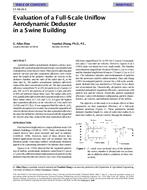
SF-98-26-5 — Evaluation of a Full-Scale Uniflow Aerodynamic Deduster in a Swine Building
A prototype uniflow aerodynamic deduster, a device aerodynamically separating dust from airstream, was installed and evaluated in a swine nursery room. Three factors affecting dust particle cut-size and dust separation efficiency were evaluated: the length of the deduster chamber, air velocity in the deduster chamber, and the ratio of the outlet duct R3 to the inner duct R1. The uniflow aerodynamic deduster effectively reduced the dust concentration in the air. The dust separation efficiency varied from 7% to 20% for particles of 1.0 µm to 2.0 µm, 30% to 67% for particles of 4.0 µm to 5.0 µm, and 40% to 80% for particles larger than 5 µm. The radius ratio of R3 to R1significantly affected the dust separation efficiency. Of the three radius ratios (0.7, 0.9, and 1.15), 0.9 gave the highest dust separation efficiency at air velocities of 3 m/s and 6 m/s (9.8 ft/s and 19.7 ft/s). It was suggested that the ratio R3 to R1 should be designed close to unity. Increasing the tangential air velocity did not always increase the dust separation efficiency because the turbulence intensity increased with the tangential air velocity and, thus, reduced the dust separation efficiency.
Units: Dual
Citation: Symposium, ASHRAE Transactions, 1998, Vol 104, pt. 1A, San Francisco
Product Details
- Published:
- 1998
- Number of Pages:
- 7
- File Size:
- 1 file , 140 KB
- Product Code(s):
- D-7938


